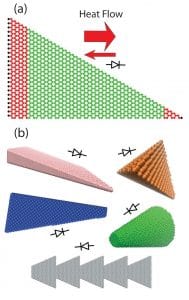
Researchers have proposed a new method of controlling heat flow similar to the way electronic components handle electrical current that could deliver more efficient thermal management in a variety of applications.
Developed by scientists at Purdue University, the technology utilizes tiny triangular or T-shaped structures made of graphene nanoribbons to control phonons, quantum mechanical phenomena that illustrate how vibrations travel between atoms and can be used to determine the rate of heat flow throughout a system.
Advanced simulations conducted by the Purdue team have shown the triangular structures offer a way to control this heat flow through a process known as “thermal rectification,” which allows heat to flow more efficiently in one direction. Their research is published in the journal Nano Letters.
“In most systems, heat flow is equal in both directions, so there are no thermal devices like electrical diodes. However, if we are able to control heat flow like we control electricity using diodes, then we can enable a lot of new and exciting thermal devices including thermal switches, thermal transistors, logic gates and memory,” Xiulin Ruan, an associate professor in Purdue University’s School of Mechanical Engineering and Birck Nanotechnology Center. Ruan and his research team collaborated with a group led by Yong Chen, an associate professor in Purdue’s Department of Physics and School of Electrical and Computer Engineering, on the project. “People are just starting to understand how it works, and it is quite far from being used in applications.”
Thermal rectification, in addition to being present in the graphene triangular structures, can also be seen in other “asymmetric nanostructure materials” including thin films, pyramidal quantum dots, nanocones and triangles, say the researchers. These structures can be linked to produce larger structures and better rectification performance. Once perfected, the concept could be used to control heat flow in a number of fields, including computers and electronics, clothing and buildings.
“For example, on a winter night you don’t want a building to lose heat quickly to the outside, while during the day you want the building to be warmed up by the sun, so it would be good to have building materials that permit the flow of heat in one direction, but not the other,” Ruan said.
The new research could also provide a breakthrough in the development of thermal transistors. Engineers have begun to design and test thermal transistors with some success in recent years, but overall the work remains in its infancy. Unlike conventional transistors, says Chen, thermal transistors would not require the use of silicon, are based on phonons rather than electrons and may make use of the waste heat already generated by most electronic devices.










